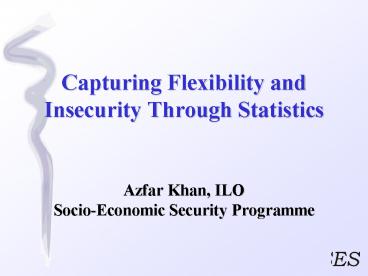Capturing Flexibility and Insecurity Through Statistics - PowerPoint PPT Presentation
1 / 20
Title:
Capturing Flexibility and Insecurity Through Statistics
Description:
making decentralization and out-sourcing more feasible and profitable ... in part because skills become obsolescent more quickly and because few workers ... – PowerPoint PPT presentation
Number of Views:18
Avg rating:3.0/5.0
Title: Capturing Flexibility and Insecurity Through Statistics
1
Capturing Flexibility and Insecurity Through
Statistics
- Azfar Khan, ILOSocio-Economic Security Programme
2
Instruments
- Enterprise Labour Flexibility and Security
Surveys (ELFS) - Establishment level
- People Security Surveys (PSS)
- Individual level
3
Flexibility and Security Structure
4
Flexibility and Security Structure
5
Institutional Considerations
- A reorientation of regulatory systems
- greater emphasis on individual freedom and less
on collective action or protection
- Technological change
- accelerating changes in production techniques
- making multi-site production possible
- making decentralization and out-sourcing more
feasible and profitable - more options for labour arrangements, payment
systems, etc.
6
Perceived Considerations
- Global informalization of economic activity,
involving a spread of forms of labour and work
not covered by protective regulatory and social
protection systems.
- Global growth of flexible production and labour
markets, linked in part to the technological
change and globalization, and involving the
following
7
Perceived Considerations
- Organizational flexibility
- more turnover of firms, more use of
sub-contracting and production chains, and a
tendency to contract the employment function
- Numerical flexibility
- more use of external labour, such as contract
workers, outworkers, homeworkers, agency labour,
temporary workers, and teleworkers - Functional flexibility
- greater change in work tasks, job rotation, and
skill
8
Perceived Considerations
- Working time flexibility
- more continuous working, flexible hours, etc.
- Wage system flexibility
- a shift from fixed to flexible wages,
monetization of remuneration, greater use of
bonuses, etc. - Labour force flexibility
- less attachment to sectors, companies or
occupational groups, erosion of collective
labour, and greater tendency for workers to move
in and out of the labour market and labour force.
9
The Enterprise Labour Market
10
Labour Market Security
PSS
- Main work activity (by time spent)
- Work status
- Working for wages
- Regular/casual employment
- Contract labour
- Own account worker
- Primary or secondary activity
11
Measuring Social Income
- SI W EB SB PB CB
where W the money wage and/or money income
received from different types of economic
activities EB the total value of benefits
provided by the enterprise as non-wage benefits
and insurance type supports SB the total value
of benefits provided by the state, which are
taken to include citizenship benefits, insurance
based income transfers and discretionary
means-tested transfers PB total value of
benefits accruing from private income, either
through investments, ownership of assets and
privately contracted social protection CB the
benefits accruing through a reliance on
traditional communal and family support systems
12
Wage Flexibility Loop
13
Wage Flexibility Loop
14
Income Security
PSS
- Regularity of income
- Form of remuneration
- Main method of payment (wage based, piece rate,
job based) - Benefits (health care, maternity benefits,
redundancy payments, pension entitlements,
disability benefits, subsidies for schooling,
etc.)
15
Employment Security
ELFS
- Labour turnover
- Changes in employment structure (regular vs.
non-regular)
PSS
- Period of unemployment
- Terms of employment termination
- Severance payment
- Provision of other entitlements
16
Work Security
ELFS
- Number of work-related accidents, working time
lost, etc. - Committee/department to protect workers
PSS
- OSH conditions, workplace hazards
17
Skill Reproduction Security
ELFS
- Providing initial training, retraining, training
to upgrade - Forms of training
- Subsidizing training institute
PSS
- Access to training for regular and non-regular
workers (especially for informal workers)
18
ELFS and PSS Carried Out
19
Discerned Results
- Labour Market Insecurity has grown almost
globally, with much higher unemployment, slower
rates of employment growth and higher labour
slack.
- Employment Insecurity is high and rising, with
growing proportions of those in the labour force
having insecure employment statuses and with more
workers lacking employment protection.
20
Discerned Results
- Work Insecurity has become greater, due to more
people being in work statuses without coverage by
protective institutions and regulations.
- Job Insecurity has worsened, with more workers
having to switch jobs and learn new tricks of
working. - Skill Reproduction Insecurity is considerable
with flexibility, in part because skills become
obsolescent more quickly and because few workers
are receiving career skills.

